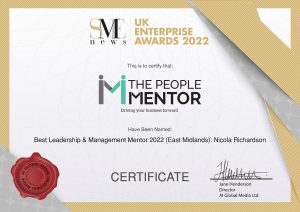Many moons ago I can recall walking into a huge storm from two of my team members.
I was young and inexperienced and really struggled with how to deal with it. I met with both members and listened to their side of the argument.
It was all about the previous manager sharing work out and one felt he had the lion’s share.
I managed to elicit agreement they would take part in a mediation session, which they attended.
As a result, they sorted their differences and went back to being friends. That was my first experience of dealing with a serious conflict. Thank goodness it turned out okay, especially as I was given no training.
What it did make me realise was that I needed to actively tune into what was going on in the team and observe.
I had missed the warning signs of silences and the two team members not speaking to each other.
Taking no notice of conflict, doesn’t mean it will go away, quite the reverse. As in my case it can escalate.
A negative atmosphere and areas of conflict can make our experiences in the workplace, demoralising and a struggle to want to go to work. It usually affects our performance and productivity too.

Workplace conflict can range from:
- Difference of opinions
- Violence and intimidation
- Sexual harassment
- Bullying and harassment.
You need to understand if you do nothing, then the situations quickly escalate and lead to serious outcomes ranging from grievances, disciplinaries, unfair dismissal and employment tribunals.
Addressing conflict needs to be carried out openly. It will create an environment where your team can express their opinions freely and work out their differences in a constructive way.
So where do you begin?
Tips to prevent conflict
Positive Behaviours
The first thing is you need to demonstrate positive behaviours. Your attitudes and behaviours have a powerful effect on the team. When dealing with a conflict situation be aware of your body language and words you are using.
You need to set the right example ….
To help with this:
- Use active listening
- Use a non-threatening assertive approach
- Be aware of how people are feeling
- Be conscious of the impact emotional understanding can have
Be self-aware
Being self-aware of your actions makes a huge difference to how your team perceive the team environment.
If you are a manger who:
- withholds key decisions or business plans because they could be opposed.
- fails to pass on important information about changes, or developments to the areas your team is working on.
- cancels or defers meetings without a good valid reason
- sets unrealistic goals or deadlines which puts people under pressure.
- and fails to set clear roles and responsibilities.
Then you are setting up the potential for conflict inadvertently on your team.
If you recognise yourself in any of those then you need to make changes.
The biggest key to this is to plan in time for you to reflect on your leadership and management. I’d recommend encouraging the team to review what is going well and what could be even better. Create a space where they feel they can open up without repercussions.

Set Clear Boundaries
Part of your role as a manager or the business owner is to set clear boundaries so everyone knows where they stand. This can range from policies, behaviour statements to the values of the business.
It is your responsibility to share and exhibit them.
Often you will see roles and responsibilities blurred across the team. This causes confusion and people stepping on each other toes. It can also create issues with who has authority for what.
If responsibilities aren’t spelt out people can reject or overstep the lines. In turn you can see power squabbles and discord across the team.
How do you turn this around? Work with the team to bring in defined roles and responsibilities to create clarity. Involving the team in this will generate the buy-in and allows them to share with each other what they do. It gives an opportunity too, to share any issues and resolve them
Once agreement reached communicate these so everyone knows and keep them in a central place.
Have regular 1-2-1s
Conflict can be healthy, let’s not forget that. It opens up new ideas and helps get problems solved, providing you handle the conflict the right way. However, if you don’t deal with the conflict it ends up with a frosty environment and more.
One way to be on top of situations is to have 1-2-1s frequently.
Having conversations individually with your team members will help by:
- Getting to know the different personalities
- Identifying possible personality clashes
- Taking the temperature of the current working situation
- Understanding potential flashpoints
Time and time I see team members thinking there are favourites within the team, or that their manager isn’t listening to their ideas and thoughts. Other times the team are losing the focus or struggling with changes going on. When that happens rumblings start and over time it reaches a crescendo. Leading to explosions and an unhealthy atmosphere.
Creating trust in your team will open the communication lines when you have 1-2-1s.
Your conflict style
You will have a default style and being aware of which one you can revert to will help you in different situations.
Knowing the 5 types means you can adapt as needed to reduce conflict and create a smoother path.
- Avoiding – This is where the person avoids the conflict at all costs. Often you will see the person asking others to make decisions and not wanting to hurt other’s feelings.
- Competing – Usually, these people are firm and know exactly what they want. In urgent situations, this style is useful as gets quick results and movement. However, use this in less urgent situations and you will see resentment and injured feelings.
- Compromising – This is about partially finding an answer for everyone. Generally, everyone gets to lose something including the initiator. This can be useful when the cost of the conflict is going to be higher than losing something.
- Collaborating – This style is about trying to meet the needs of all. These people are assertive yet will always want to cooperate and value everyone and their input. A useful style when pulling viewpoints together to get the best outcome for the business.
- Accommodating – With this style the person will meet the needs of others above themselves. Often, they will give in even when not needed. This works when peace is more valuable than winning or when you want to bargain for the future.

What is important is to deal with the conflict and not leave it festering.
Seeing conflict and feeling unsure how to get your teams back on an even footing?
I can help.
Struggling to justify the cost, then think of it like this, if you don’t deal with the conflict, it will only keep spewing like a volcano until eventually it erupts leaving devastation in its wake.
Book a discovery call now.






